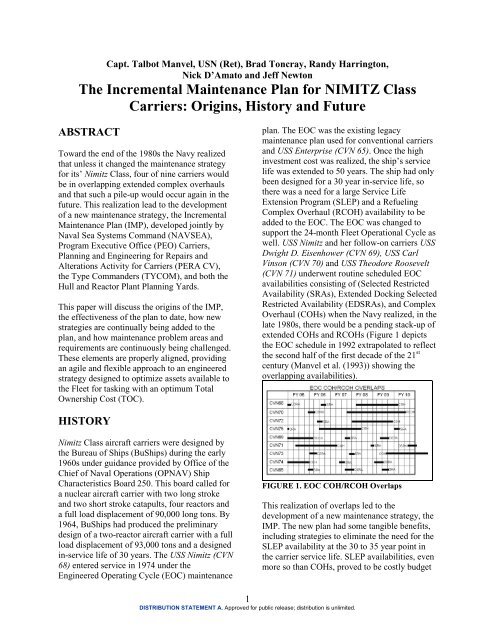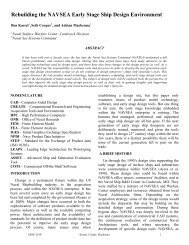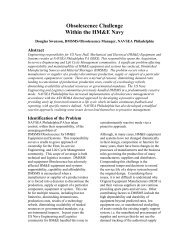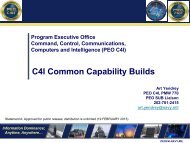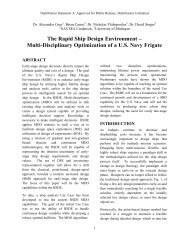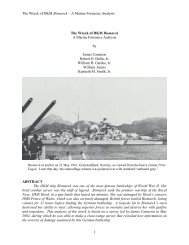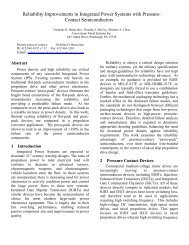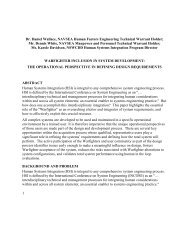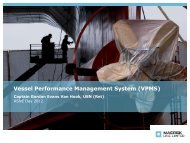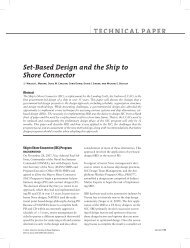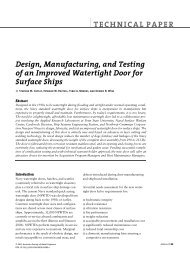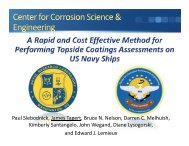FMS2010 IMP Paper - ASNE
FMS2010 IMP Paper - ASNE
FMS2010 IMP Paper - ASNE
Create successful ePaper yourself
Turn your PDF publications into a flip-book with our unique Google optimized e-Paper software.
Capt. Talbot Manvel, USN (Ret), Brad Toncray, Randy Harrington,<br />
Nick D’Amato and Jeff Newton<br />
The Incremental Maintenance Plan for NIMITZ Class<br />
Carriers: Origins, History and Future<br />
ABSTRACT<br />
Toward the end of the 1980s the Navy realized<br />
that unless it changed the maintenance strategy<br />
for its’ Nimitz Class, four of nine carriers would<br />
be in overlapping extended complex overhauls<br />
and that such a pile-up would occur again in the<br />
future. This realization lead to the development<br />
of a new maintenance strategy, the Incremental<br />
Maintenance Plan (<strong>IMP</strong>), developed jointly by<br />
Naval Sea Systems Command (NAVSEA),<br />
Program Executive Office (PEO) Carriers,<br />
Planning and Engineering for Repairs and<br />
Alterations Activity for Carriers (PERA CV),<br />
the Type Commanders (TYCOM), and both the<br />
Hull and Reactor Plant Planning Yards.<br />
This paper will discuss the origins of the <strong>IMP</strong>,<br />
the effectiveness of the plan to date, how new<br />
strategies are continually being added to the<br />
plan, and how maintenance problem areas and<br />
requirements are continuously being challenged.<br />
These elements are properly aligned, providing<br />
an agile and flexible approach to an engineered<br />
strategy designed to optimize assets available to<br />
the Fleet for tasking with an optimum Total<br />
Ownership Cost (TOC).<br />
plan. The EOC was the existing legacy<br />
maintenance plan used for conventional carriers<br />
and USS Enterprise (CVN 65). Once the high<br />
investment cost was realized, the ship’s service<br />
life was extended to 50 years. The ship had only<br />
been designed for a 30 year in-service life, so<br />
there was a need for a large Service Life<br />
Extension Program (SLEP) and a Refueling<br />
Complex Overhaul (RCOH) availability to be<br />
added to the EOC. The EOC was changed to<br />
support the 24-month Fleet Operational Cycle as<br />
well. USS Nimitz and her follow-on carriers USS<br />
Dwight D. Eisenhower (CVN 69), USS Carl<br />
Vinson (CVN 70) and USS Theodore Roosevelt<br />
(CVN 71) underwent routine scheduled EOC<br />
availabilities consisting of (Selected Restricted<br />
Availability (SRAs), Extended Docking Selected<br />
Restricted Availability (EDSRAs), and Complex<br />
Overhaul (COHs) when the Navy realized, in the<br />
late 1980s, there would be a pending stack-up of<br />
extended COHs and RCOHs (Figure 1 depicts<br />
the EOC schedule in 1992 extrapolated to reflect<br />
the second half of the first decade of the 21 st<br />
century (Manvel et al. (1993)) showing the<br />
overlapping availabilities).<br />
HISTORY<br />
Nimitz Class aircraft carriers were designed by<br />
the Bureau of Ships (BuShips) during the early<br />
1960s under guidance provided by Office of the<br />
Chief of Naval Operations (OPNAV) Ship<br />
Characteristics Board 250. This board called for<br />
a nuclear aircraft carrier with two long stroke<br />
and two short stroke catapults, four reactors and<br />
a full load displacement of 90,000 long tons. By<br />
1964, BuShips had produced the preliminary<br />
design of a two-reactor aircraft carrier with a full<br />
load displacement of 93,000 tons and a designed<br />
in-service life of 30 years. The USS Nimitz (CVN<br />
68) entered service in 1974 under the<br />
Engineered Operating Cycle (EOC) maintenance<br />
FIGURE 1. EOC COH/RCOH Overlaps<br />
This realization of overlaps led to the<br />
development of a new maintenance strategy, the<br />
<strong>IMP</strong>. The new plan had some tangible benefits,<br />
including strategies to eliminate the need for the<br />
SLEP availability at the 30 to 35 year point in<br />
the carrier service life. SLEP availabilities, even<br />
more so than COHs, proved to be costly budget<br />
1<br />
DISTRIBUTION STATEMENT A. Approved for public release; distribution is unlimited.
targets and reduced carrier operational<br />
availability and were found to miss the mark on<br />
completely re-baselining material readiness due<br />
to underfunding maintenance requirements.<br />
COHs themselves were also problematic in that<br />
availability durations routinely extended far<br />
beyond proscribed Chief of Naval Operations<br />
(CNO) completion dates, with delays averaging<br />
101 days between 1983 and 1995. Figure 2<br />
shows the improved <strong>IMP</strong> FY05 to FY10<br />
maintenance schedule.<br />
<br />
<br />
<br />
<br />
<br />
Focus on published technical requirements<br />
Learn from depot level repair experiences<br />
Incorporate data from similar equipment and<br />
maintenance strategies used elsewhere in the<br />
fleet<br />
Enact best practices and LEAN initiatives<br />
where appropriate and,<br />
Create ship alterations to address barriers<br />
when required.<br />
Under the EOC plan the strategy was to allow<br />
the ships material condition to gradually<br />
degrade, then return the material condition to a<br />
higher state of readiness during COHs. In<br />
practice, the resulting readiness state never<br />
reached the previous benchmark (Figure 3).<br />
FIGURE 2. <strong>IMP</strong> Actual PIA/DPIA/RCOH<br />
Overlaps<br />
PHILOSOPHY, STRATEGY,<br />
PLAN DEVELOPMENT AND<br />
RESULTS<br />
The philosophy of the <strong>IMP</strong> is simple:<br />
Create a plan that maintains carriers in a<br />
more consistent state of material readiness<br />
throughout its service life by executing a<br />
series of more consistently sized<br />
availabilities. This reduces the budget and<br />
shipyard workload spikes and mitigates the<br />
loss of sailor readiness suffered under the<br />
EOC’s long duration (12 to over 18 month)<br />
COHs.<br />
Do away with the need for historically time<br />
consuming and unsuccessful SLEP<br />
availabilities at the 30 to 35 year service life<br />
point by better managing carrier<br />
infrastructure and distributive system<br />
deterioration.<br />
FIGURE 3. EOC Strategy<br />
One of the strategies transitioning from EOC to<br />
<strong>IMP</strong> was to reduce or eliminate the ―gap‖<br />
created from the COH inefficiencies. The plan<br />
took mandatory and condition based<br />
maintenance man days and applied them<br />
throughout the ship’s life in a robust continuous<br />
maintenance process rather than allowing a build<br />
up to be addressed during COHs (Figure 4). In<br />
Figure 4, the EOC strategy of allowing the<br />
ship’s material condition to gradually degrade is<br />
shown as the bottom saw tooth curve, while the<br />
<strong>IMP</strong> strategy for 24-month and 32-month, with<br />
reduced long term readiness ―gap‖, are depicted<br />
as the red and blue lines, respectively.<br />
Following the <strong>IMP</strong> philosophy, the strategy is<br />
also simple:<br />
Build on historical knowledge<br />
Utilize maintenance history successes and<br />
failures<br />
2<br />
DISTRIBUTION STATEMENT A. Approved for public release; distribution is unlimited.
Level of Maintenance Condition<br />
SRA<br />
PIA<br />
PIA<br />
DSRA<br />
PIA<br />
PIA<br />
DPIA<br />
SRA<br />
DPIA<br />
PIA<br />
COH<br />
PIA<br />
PIA<br />
SRA<br />
DPIA<br />
DSRA<br />
PIA<br />
PIA<br />
SRA<br />
DPIA<br />
PIA<br />
COH<br />
DPIA<br />
SRA<br />
PIA<br />
PIA<br />
DSRA<br />
PIA<br />
PIA<br />
SRA<br />
RCOH<br />
RCOH<br />
RCOH<br />
EOC<br />
<strong>IMP</strong>-24<br />
<strong>IMP</strong>-32<br />
2 4 6 8 10 12 14 16 18 20 22<br />
Years<br />
<strong>IMP</strong> 32<br />
<strong>IMP</strong> 24<br />
FIGURE 4. EOC, <strong>IMP</strong>-24 and <strong>IMP</strong>-32 Readiness<br />
Strategy<br />
EOC vs. <strong>IMP</strong>-24<br />
Philosophy and strategy is one thing, but with<br />
concept execution, the plan development process<br />
and details were not always as simple. In order<br />
to affect a transition to the <strong>IMP</strong>, several steps<br />
were required to satisfy technical requirements<br />
in-place at the time. An initial study was<br />
conducted identify all the requirements and<br />
applicable certification durations and their<br />
impact on the new <strong>IMP</strong> cycle; the most<br />
significant being the existing 5 year docking<br />
requirement. Those identified strategies were<br />
then challenged or changed to ―push‖ or ―pull‖<br />
maintenance actions to fit within the new<br />
schedule. High cost evolutions (like dry<br />
docking) required a number of engineering<br />
changes (ship alterations) to gain technical<br />
justification to ―push‖ the requirement to 6<br />
years. Condition based assessments were<br />
implemented to assure appropriate monitoring,<br />
data collection and analysis were available to<br />
drive maintenance actions.<br />
In support of the development of the <strong>IMP</strong>, a<br />
phased maintenance strategy review was<br />
conducted. The strategy incorporated the<br />
following steps:<br />
Define a complete list of maintenance<br />
requirements with the number of affected<br />
components, equipment and systems, along<br />
with their required level of repair.<br />
Sequence maintenance actions by<br />
availabilities.<br />
EOC<br />
<br />
<br />
Account for the age of the ship within its life<br />
cycle: Modify the levels of repair based on<br />
age degradation calculations and apply an<br />
―aging factor‖ across scheduled<br />
availabilities.<br />
Employ a time-based approach to budgeting<br />
while conforming to a condition based<br />
approach to maintenance.<br />
The review evaluated requirements, workload,<br />
manning, critical paths, testing and services.<br />
The work was comprehensively ―sequenced‖<br />
and all the maintenance requirements level<br />
loaded across the ships service life. This<br />
―Sequencing Plan‖ approach became an integral<br />
building block of the shift from the EOC to <strong>IMP</strong>.<br />
The <strong>IMP</strong> was composed of repeating 24-month<br />
operating cycles with one major 6-month<br />
Planned Incremental Availability (PIA)<br />
maintenance period per cycle. Every repeating<br />
third cycle, the major maintenance availability<br />
was a 10.5-month Docking Planned Incremental<br />
Availability (DPIA).<br />
To accommodate the ―aging factor‖, budgetary<br />
baselines were established, and shipyard<br />
workload requirements were identified. Then<br />
the notional availabilities were divided into a<br />
three-tier set of notional maintenance periods<br />
categories based on anticipated man days due to<br />
the life of the ship and the expected<br />
requirements (Figure 5). Initial man day<br />
requirements were set in 1992 and have been<br />
modified as the <strong>IMP</strong> evolved.<br />
Figure 5: Notional Aircraft Carrier Life Cycle &<br />
Aging Factors<br />
Once the categories were developed, the<br />
shipyards that work on aircraft carriers reviewed<br />
them in order to determine if they were<br />
achievable in relation to capacity. Norfolk Naval<br />
3<br />
DISTRIBUTION STATEMENT A. Approved for public release; distribution is unlimited.
Shipyard (NNSY) and Puget Sound Naval<br />
Shipyard (PSNS) determined they could execute<br />
the first two categories of availabilities (called<br />
PIA1s, PIA2s, DPIA1s and DPIA2s), but that<br />
the third set (PIA3s and DPIA3s) exceeded<br />
capacity by 2,000 men per day. During the<br />
initial EOC timeframe (circa 1992) the shipyard<br />
had excess capacity (NNSY: 11,205 personnel<br />
and PSNS and IMF: 12,356 personnel). When<br />
the <strong>IMP</strong> was developed and the availability<br />
categories were defined, the Shipyards had<br />
reduced their manning significantly. By fiscal<br />
year (FY) 2004, NNSY had 7,778 personnel and<br />
PSNS and IMF was manned at 9,421 personnel.<br />
Mitigation strategies (such as contracting of<br />
additional work) were developed to compensate<br />
for the lack of manpower capacity to support the<br />
PIA3 and DPIA3’s. One strategy was to reduce<br />
the workload within the availability by having a<br />
spare available for a wholesale change out of the<br />
equipment, instead of using vital manpower to<br />
overhaul in place. The equipment would then be<br />
repaired during a time when the shipyard was at<br />
less demand. The program was called the Carrier<br />
Planned Equipment Replacement (CARPER)<br />
program.<br />
Today, man day requirements are continuously<br />
reviewed as part of the overall feedback process.<br />
Table 1 shows the original PIA/DPIA depot man<br />
day requirements and subsequent changes.<br />
TABLE 1: Original Depot Man day<br />
Requirements and Changes<br />
At the same period of time that the <strong>IMP</strong> was<br />
being developed, the carrier maintenance<br />
community established a process improvement<br />
organization called Carrier Team One (CT1), a<br />
knowledge sharing network developed to<br />
improve the execution of availabilities. Though<br />
not created directly as a result of the inception of<br />
<strong>IMP</strong>, CT1 has matured in parallel with the <strong>IMP</strong><br />
and has played no small role in its success.<br />
Advantages of <strong>IMP</strong>-24<br />
The shift from the EOC strategy to <strong>IMP</strong>-24 was<br />
a major change in the way carrier maintenance<br />
had been conducted for many years, and yielded<br />
significant gains. The 24-month operating cycle<br />
(<strong>IMP</strong>-24) provided for more consistently sized<br />
availabilities and, as a result, produced:<br />
More consistent short term and long term<br />
readiness.<br />
Increased ship availability and surge<br />
capability.<br />
Leveled the profile of the maintenance and<br />
related budget spikes by incrementally<br />
executing the work throughout the carrier’s<br />
service life.<br />
Provided ships with the right capabilities as<br />
a result of focusing on condition based<br />
maintenance and modernization.<br />
Unnecessary maintenance under the<br />
antiquated time based maintenance plan left<br />
too much variability for effective planning.<br />
Level loaded the maintenance industrial<br />
base by comprehensively listing and<br />
sequencing all the maintenance requirements<br />
by shop and trade skill.<br />
<br />
More accurate and predictable schedules and<br />
maintenance workload forecasts.<br />
COMNAVSEASYSCOM letter of June 91<br />
applied an ―Aging Factor‖ to account for the<br />
effects of aging on ship system repairs.<br />
<br />
Reduced the number of docking<br />
availabilities (EDSRA vs. DPIA) by four,<br />
resulting in:<br />
o<br />
o<br />
o<br />
Increased carrier service life operational<br />
availability (A O ) by 18 months.<br />
Reduced the number of maintenance<br />
man days by 985,000 man days per<br />
carrier over its 50 year service life<br />
(Note: The majority of these man day<br />
reductions were associated with services<br />
(project management, dry dock support)<br />
rather then ―wrench turning‖ work.<br />
Ensured all ―wrench turning‖ work<br />
reductions were the result of<br />
4<br />
DISTRIBUTION STATEMENT A. Approved for public release; distribution is unlimited.
modernization design changes or<br />
Technical Warrant Holder (TWH)<br />
approved study recommendations.<br />
New strategies were developed for components<br />
with periodic inspections (flex hoses,<br />
pressurized cylinders, tanks, voids, and wire<br />
ropes, among others). Availability durations,<br />
critical paths, trade skill demands and spare part<br />
requirements were all evaluated to optimize<br />
successful maintenance period execution. The<br />
total effect resulted in a ―Sequencing Plan‖ that<br />
reapportioned maintenance man days and<br />
workloads across the entire carrier life cycle and<br />
industrial infrastructure. The Sequencing Plan<br />
included the deletion of inefficient SLEP<br />
availabilities. Although not always tied directly<br />
to the <strong>IMP</strong> effort, the carrier maintenance<br />
community leadership had introduced specific<br />
system upgrades (ship alterations) to extend the<br />
service life of systems determined to be in<br />
jeopardy beyond 30 years (e.g., changing 90/10<br />
firemain piping to 70/30 copper nickel).<br />
Additionally, original design infrastructure and<br />
distributive system service margins (electrical<br />
power, fiber optic cable plant status, chill water<br />
capacity, firemain, etc.) were closely monitored<br />
using a program called the Ships System Status<br />
Program (SSSP).<br />
The <strong>IMP</strong> was officially approved as the CVN<br />
68’s Class Maintenance Plan in 1994 and the<br />
first PIA was executed in FY97. As <strong>IMP</strong><br />
availabilities were completed, the entire <strong>IMP</strong><br />
approach was validated. A Carrier unique<br />
Project Management College (PMC) was<br />
instituted under the leadership of the newly<br />
established CT1. Post availability ―Hot<br />
Washes‖ were reviewed, and the planning and<br />
execution successes and failures and<br />
―knowledge sharing‖ elements of CT1 all<br />
contributed to the overall positive validation<br />
process.<br />
EVOLUTION OF THE <strong>IMP</strong><br />
When the <strong>IMP</strong> was first established,<br />
―maintenance‖ was scheduled based upon a<br />
consistent and predictable 24-month operational<br />
cycle of ―heel-to-toe‖ deployments. In 2001,<br />
operational demands associated with the events<br />
following September 11, 2001 resulted in an<br />
increase in the average length between <strong>IMP</strong><br />
availabilities from 24-months to 27-months as<br />
allowed by OPNAVNOTE 4700 tolerances.<br />
<strong>IMP</strong>-24 vs. <strong>IMP</strong>-27 vs. <strong>IMP</strong>-32<br />
In 2004, the operational cycle for a CVN 68<br />
Class Aircraft Carrier was officially modified<br />
and recognized in the OPNAVNOTE 4700 of<br />
June 2004 as 27 months. Adoption of a<br />
27-month cycle resulted in a reduction of the<br />
total number of depot availability opportunities<br />
executed and the elimination of approximately<br />
400,000 man days of life cycle maintenance.<br />
The most significant factor related to the 2004<br />
transition to a 27-month operational cycle was<br />
the determination to not adjust or modify<br />
programmed notional man days to account for<br />
the two (2) deleted PIAs, one during each half of<br />
the ship’s life (12 months of depot time).<br />
Because of the heavily condition based <strong>IMP</strong>, as<br />
well as the usage of better materials and<br />
preservation systems, it was assessed there<br />
would be negligible impact on material<br />
readiness in extending the operational cycle by<br />
three months.<br />
Concurrently in 2004, in an effort to provide<br />
even more operational availability to fleet<br />
commanders, Commander, NAVSEA requested<br />
PMS 312, under PEO Carriers, evaluate the<br />
technical feasibility of increasing the length<br />
between availabilities from 27-months to<br />
32-months. This technical review by all<br />
maintenance stakeholders, coincident with<br />
technical approval to extend the dry-docking<br />
interval for the Nimitz Class to 8 years,<br />
concluded that there were no technical<br />
impediments to extending the time between<br />
depot availabilities to 32-months. The dry-dock<br />
interval extension–from 6 years to 8 years—<br />
required a full technical review which validated<br />
the extension, represented an acceptable and<br />
manageable level of risk, and was approved by<br />
the Technical Warrant Holders (TWH) as<br />
outlined in PEO Carriers letter of March 2005.<br />
The major 32 month/8 year docking Study<br />
concluded in 2006 with the approval of the 32-<br />
5<br />
DISTRIBUTION STATEMENT A. Approved for public release; distribution is unlimited.
DPIA3<br />
DPIA3<br />
DPIA3<br />
PIA3<br />
CIA 3<br />
PIA3<br />
CIA 3<br />
CIA 3<br />
PIA3<br />
CIA 3<br />
PIA3<br />
CIA 3<br />
CIA 2<br />
PIA2<br />
CIA 2<br />
PIA2<br />
CIA 2<br />
CIA 3<br />
PIA3<br />
CIA 3<br />
PIA3<br />
CIA 3<br />
CIA 2<br />
PIA2<br />
PIA2<br />
DPIA2<br />
CIA 1<br />
PIA1<br />
PIA1<br />
CIA 2<br />
CIA 2<br />
CIA 1<br />
CIA 1<br />
month operating cycle (<strong>IMP</strong>-32). This last<br />
iteration has had the following additional<br />
benefits to the Navy and the Fleet:<br />
An additional reduction in the number of<br />
CNO availabilities by four; two PIAs and<br />
two DPIAs (totaling 33 months of depot<br />
time over the lifecycle of each aircraft<br />
carrier).<br />
An increase in a carrier’s service life A O by<br />
an additional 11 months from <strong>IMP</strong>-24 to<br />
<strong>IMP</strong>-32.<br />
Although providing more A O , the loss of these<br />
availabilities resulted in the removal of 1.12M<br />
man days of original depot level work.<br />
Approximately half of these man days are<br />
associated with items such as test programs and<br />
docking costs (services) that are completely<br />
eliminated and result in actual cost avoidances.<br />
The remaining half is actual maintenance<br />
requirements that must be accounted for and<br />
reprogrammed into the updated class<br />
maintenance plan. A Continuous Maintenance<br />
(CM) strategy was developed using Carrier<br />
Incremental Availabilities (CIAs) to incorporate<br />
a portion of the missed requirements. Another<br />
change was the increase in size of some DPIAs<br />
by one category (e.g., DPIA1 to DPIA2). The<br />
latest <strong>IMP</strong> strategy increases platform<br />
availability to the operator in support of a Fleet<br />
Response Plan (FRP) 6 available aircraft carriers<br />
plus 1 in docking (6+1) philosophy and includes<br />
the CM Strategy.<br />
In order to account for the displaced 433,000<br />
―wrench turning‖ maintenance man days<br />
removed by the reduction of maintenance<br />
availabilities, every maintenance opportunity has<br />
been utilized, including a reprogramming of the<br />
―wrench turning‖ man days into the remaining<br />
DPIAs and newly established CIAs, depicted in<br />
Figure 6.<br />
53.1k MDs<br />
Over DPIA1<br />
20.6 k<br />
MDs Btwn<br />
Each Avail<br />
32-Month Operational Cycle Continuous<br />
Maintenance<br />
24.2 k MDs<br />
Btwn Each<br />
Avail<br />
47.7k MDs<br />
Over DPIA2<br />
27.8 k MDs<br />
Btwn Each<br />
Avail<br />
24.2 k MDs<br />
Btwn Each<br />
Avail<br />
148.5k Mandays Redistributed<br />
47.7k MDs<br />
Over DPIA2<br />
27.8k MDs<br />
Btwn Each<br />
Avail<br />
FIGURE 6. 32-Month Operational Cycle with<br />
Continuous Maintenance<br />
The evolution of the <strong>IMP</strong> from its inception has<br />
resulted in a total 937,300 maintenance man<br />
days reduction per ship over its 50 year service<br />
life by removing services associated with 6<br />
fewer availabilities.<br />
RESULTS—ADVANTAGES OF<br />
<strong>IMP</strong> OVER EOC<br />
Since implementing <strong>IMP</strong>-24 the aircraft carrier<br />
maintenance community has continued to<br />
challenge maintenance requirements as part of<br />
ongoing total ownership cost improvement<br />
initiatives. This evolution has resulted in<br />
improved benefits that include:<br />
Fleet Benefits<br />
o Increased platform readiness (Ao)<br />
o Material ready assets<br />
o Assets with the right capabilities at the<br />
right time<br />
o Improved confidence in Budget<br />
Requirements and Schedules<br />
TYCOM Benefits<br />
o Reduced maintenance costs<br />
o Improved maintenance forecasting<br />
capability<br />
o Levelized funding - easily defendable.<br />
Maintenance Providers Benefits<br />
o Improved maintenance forecasting<br />
o Levelized shipyard loading; including at<br />
the shop and trade skill levels<br />
Ships Force Benefits<br />
o Better able to maintain qualification<br />
proficiency<br />
o More predictable schedules<br />
6<br />
DISTRIBUTION STATEMENT A. Approved for public release; distribution is unlimited.
K-Man-days<br />
Deviation from OPNAV Completion (Days)<br />
Deviation From OPNAV Completion (Days)<br />
The evolution of the <strong>IMP</strong> provides critical<br />
short-term (current) readiness to support<br />
post-9/11 FRP surge requirements, while<br />
accommodating long-term (future) readiness by<br />
minimizing infrastructure and distributive<br />
system deterioration ―gaps‖ to ensure full<br />
service life at a significantly reduced cost.<br />
400<br />
350<br />
300<br />
250<br />
200<br />
150<br />
100<br />
50<br />
CVN68 CL Depot Availability Duration History - EOC<br />
Figure 7 illustrates the ―step down‖ in total<br />
maintenance man day costs resulting from the<br />
sequential move from EOC to the <strong>IMP</strong>-32. The<br />
seven per cent (7%) increase in man days from<br />
the 1994 <strong>IMP</strong>-24 to the 2002 <strong>IMP</strong>-24 is a result<br />
of quality of life (QOL) initiatives which shifted<br />
work traditionally accomplished by ships force<br />
(such as fire watches) to maintenance providers.<br />
0<br />
(50)<br />
(100)<br />
1982 1984 1986 1988 1990 1992 1994 1996 1998<br />
FIGURE 8. EOC Availability Duration History –<br />
EOC<br />
400<br />
350<br />
300<br />
250<br />
CVN68 CL Depot Availability Duration History - <strong>IMP</strong><br />
7000<br />
200<br />
150<br />
6000<br />
100<br />
5000<br />
- 22 %<br />
+ 7 %<br />
- 6 %<br />
- 14 %<br />
50<br />
0<br />
4000<br />
(50)<br />
(100)<br />
1994 1996 1998 2000 2002 2004 2006 2008 2010<br />
3000<br />
2000<br />
FIGURE 9. Depot Availability Duration History -<br />
<strong>IMP</strong><br />
1000<br />
0<br />
1992 EOC 1994 <strong>IMP</strong>-24 2002 <strong>IMP</strong>-24 2004 <strong>IMP</strong>-27 2006 <strong>IMP</strong>-32<br />
FIGURE 7. Comparison of Carrier Life Cycle<br />
Man day Totals<br />
Based on Programs of Record, there has been a<br />
reduction of approximately 2 million man days<br />
per carrier over its 50 year service life<br />
(excluding Shipbuilding and Conversion, Navy<br />
(SCN) funded RCOH), equating to roughly $1B<br />
cost avoidance per carrier.<br />
The <strong>IMP</strong> strategy to develop precisely planned<br />
availabilities, tailored to accommodate shipyard<br />
shop and trade skill capabilities, combined with<br />
CT1 project management initiatives have<br />
resulted in significantly improved availability<br />
execution. Figure 8 depicts the deviation from<br />
OPNAV established maintenance duration the<br />
carrier community experienced under the EOC.<br />
Figure 9 is a similar scatter gram reflecting<br />
availabilities after implementation of the <strong>IMP</strong><br />
and shows a significant improvement of<br />
schedule adherence.<br />
A comparison of the notional data indicates that<br />
depot time under the EOC was 33% of a carrier<br />
life cycle versus only 20% under the <strong>IMP</strong>-32. It<br />
should be noted that the data excludes RCOH<br />
and Post-RCOH Post Shakedown Availability<br />
(PSA)/SRA timelines.<br />
<strong>IMP</strong> FUNCTIONALITY<br />
The <strong>IMP</strong> gains its functionality from the<br />
foundation by which it was built. Clearly<br />
identified and articulated technical requirements<br />
are the cornerstones while hard lessons learned<br />
from historical challenges provide the structural<br />
strength. Inputs to the <strong>IMP</strong> are (1) Core<br />
technical requirements and (2) Historical<br />
feedback requirements (Figure 10 (Note: The<br />
information flow is BI-DIRECTIONAL for all<br />
these functions except for historical feedback<br />
(which by definition is unidirectional)).<br />
Requirements, Budgets, Workload Forecasting<br />
and Baseline Availability Work Package<br />
(BAWP) development are iteratively updated as<br />
feedback information validates (or invalidates)<br />
7<br />
DISTRIBUTION STATEMENT A. Approved for public release; distribution is unlimited.
and refines the information contained in the<br />
<strong>IMP</strong>.<br />
FIGURE 10. Functions of the <strong>IMP</strong><br />
Requirements: The <strong>IMP</strong> serves as the single<br />
authoritative repository of all ―off ship‖<br />
technical maintenance requirements defined by<br />
higher order documents such as Naval Ship<br />
Technical Manuals (NSTM’s), General<br />
Specifications for Overhaul (GSO), Steam and<br />
Electric Plant Manual, etc. The key<br />
organizations (not all inclusive), which set the<br />
requirements are: OPNAV, SEA 05, SEA 08,<br />
Naval Air Systems Command (NAVAIR),<br />
Naval Surface Warfare Center (NSWC),<br />
Commander Naval Air Forces (CNAF), etc. ―On<br />
ship‖ technical maintenance requirements are<br />
managed through the Preventative Maintenance<br />
Schedule (PMS).<br />
Feedback: The <strong>IMP</strong> serves as the repository of<br />
historical execution feedback from the Naval<br />
Supervising Authority (NSA), In-Service<br />
Engineering Agents (ISEAs), etc. required to<br />
continuously validate and improve the plan<br />
itself.<br />
The key Output functions of the <strong>IMP</strong> are:<br />
To develop notional budgets for OPNAV<br />
and the Program Objective Memorandum<br />
(POM) process.<br />
To develop the Material Unit Cost (MUC)<br />
rates for COMNAVAIRFOR. This MUC is<br />
used to convert expected Material demands<br />
to a man day rate in order to budget under<br />
the same units.<br />
To develop workload forecasts for SEA 04<br />
in order to project the industrial base<br />
workload for future years.<br />
To develop BAWPs for the Naval Aviation<br />
Enterprise (NAE).<br />
To serve as the single authoritative data<br />
repository for ―off ship‖ maintenance<br />
requirements and financial information to<br />
enable ―war gaming/what if‖ data calls. An<br />
example of this was the ability to generate a<br />
2,600 page ―cradle to grave‖ forecast of<br />
Baseline Availability Work Package<br />
(BAWP) technical requirements for a<br />
―generic‖ aircraft carrier over its entire 50<br />
year in-service life. This package was used<br />
by OPNAV during POM12 to show that the<br />
notional allowances being requested were<br />
based on known and required work.<br />
Through ongoing review and continuous update<br />
of the <strong>IMP</strong>, the Carrier Planning Activity (CPA)<br />
(PMS 312C) accomplishes:<br />
Workload and financial notional reviews.<br />
Validation or improvements to the<br />
assessment plans.<br />
Availability work package growth analysis.<br />
<strong>IMP</strong> Flexibility – Double Deployments<br />
Under the <strong>IMP</strong>-24 there was only one<br />
deployment between maintenance periods. Table<br />
2, shows the <strong>IMP</strong>-32 flexibility to increased<br />
deployments when required, e.g., to date five (5)<br />
carriers have ―double deployed‖ between their<br />
maintenance periods. Review of maintenance<br />
data shows no significant increase in the Job<br />
Control Numbers (JCNs) the ―double deployed‖<br />
ships reported versus JCNs reported by the end<br />
of their single deployment operational cycles.<br />
8<br />
DISTRIBUTION STATEMENT A. Approved for public release; distribution is unlimited.
SRA<br />
SRA<br />
SRA<br />
SRA<br />
SRA<br />
SRA<br />
SRA<br />
SRA<br />
Carrier Action Date Start Date End<br />
CVN 68 PIA2 03/01/2006 08/30/2006<br />
Deploy 04/02/2007 09/30/2007<br />
Deploy 01/24/2008 06/03/2008<br />
PIA2 06/16/2008 12/16/2008<br />
CVN 69 PIA2 01/22/2008 07/23/2008<br />
Deploy 02/21/2009 07/30/2009<br />
Deploy 01/04/2010 Est. 07/2010<br />
PIA2 09/01/2010 02/28/2011<br />
CVN 70 PIA3 04/01/2002 08/30/2002<br />
Deploy 02/07/2003 09/18/2003<br />
Deploy 01/13/2005 07/13/2005<br />
RCOH 11/10/2005 07/11/2009<br />
CVN 72 DPIA2 06/23/2003 06/07/2004<br />
Deploy 10/15/2004 03/05/2005<br />
Deploy 02/27/2006 08/08/2006<br />
PIA3 09/05/2006 06/30/2007<br />
CVN 76 PIA1 05/01/2007 10/30/2007<br />
Deploy 05/19/2008 11/25/2008<br />
Deploy 05/28/2009 10/21/2009<br />
PIA1 11/09/2009 05/09/2010<br />
TABLE 2. ―Double Deploying‖ Carriers<br />
<strong>IMP</strong> Flexibility – Forward Deployed<br />
Naval Force (FDNF) Aircraft Carrier<br />
In 2008 a Nimitz Class aircraft carrier, USS<br />
George Washington (CVN 73), replaced USS<br />
Kitty Hawk (CV 63) as the Forward Deployed<br />
Naval Forces (FDNF) carrier in Yokosuka,<br />
Japan. This is the first time a nuclear powered<br />
vessel has been systematically maintained<br />
outside of the United States in a tethered<br />
forward deployed status.<br />
CVN 73 was under the CVN 68 Class <strong>IMP</strong>, and<br />
transitioned as the FDNF carrier to a modified<br />
<strong>IMP</strong> strategy utilizing annual 120-day SRAs in<br />
lieu of the 32/8 strategy detailed above. The 32/8<br />
CVN 68 Class <strong>IMP</strong> maintenance approach was<br />
considered for the forward deployed<br />
environment. Due to the unique forward<br />
deployed operational requirements of the FDNF,<br />
the 32/8 strategy did not support six consecutive<br />
months with the assigned carrier in a<br />
maintenance status. Two other availability<br />
scheduling options previously applied to the<br />
conventionally-powered aircraft carriers in<br />
Yokosuka were given primary consideration.<br />
Those two options were:<br />
Two annual 70-day availabilities and<br />
notional 15-day upkeep.<br />
Single annual 120-day availability and<br />
notional 30-day upkeep.<br />
The strategy involving the annual 120-day SRA<br />
(Figure 11) was selected primarily due to the<br />
following advantages:<br />
Consistent with FDNF Operational<br />
requirements.<br />
One availability start-up period and one test<br />
program per year vice two.<br />
Increased capability to accomplish more<br />
significant repairs/modernization during the<br />
longer maintenance period.<br />
Reduced overlap between planning of a<br />
follow-on availability and the execution of<br />
an ongoing availability.<br />
More efficient scheduling and execution of<br />
required work during the longer<br />
availabilities.<br />
2007<br />
FDNF Maintenance Schedule<br />
2008 2009 2010 2011 2012 2013 2014 2015 2016 2017 2018 2019<br />
DPIA PIA PIA RCOH<br />
<strong>IMP</strong> Maintenance Schedule<br />
FIGURE 11. Comparison of FDNF and <strong>IMP</strong><br />
Maintenance Schedules<br />
Building on both technical requirements and<br />
historical lessons learned, the scheduling of<br />
discrete ―work packages‖, and appropriately<br />
fitting the FDNF maintenance profile was both<br />
efficient and effective. The flexibility and<br />
functionality of the <strong>IMP</strong> was again proven.<br />
Managing the Plan (<strong>IMP</strong>)<br />
As can be seen by its evolution to date, the plan<br />
(<strong>IMP</strong>) has never been static, and has resulted in<br />
improved benefits as it moved from <strong>IMP</strong>-24 to<br />
<strong>IMP</strong>-27 to the current <strong>IMP</strong>-32 and <strong>IMP</strong>-FDNF.<br />
The carrier maintenance community is<br />
constantly challenging the plan and its<br />
underpinning requirements, and incorporating<br />
new strategies and tools to handle emerging<br />
issues and maintenance problem areas.<br />
Through teaming with Submarine Maintenance<br />
Engineering Planning and Procurement Activity<br />
(SUBMEPP) and the Surface Ship Life Cycle<br />
Management (SSCLM) Activity, and by<br />
identifying and using best practices and tools of<br />
other maintenance communities, NAE has been<br />
able to accelerate their efforts to increase the<br />
RCOH<br />
9<br />
DISTRIBUTION STATEMENT A. Approved for public release; distribution is unlimited.
efficiency of the <strong>IMP</strong>. Their involvement in<br />
organizations that make a difference to the base<br />
requirements, such as the Common Maintenance<br />
Plan Working Group (CMPWG) and<br />
Cumbersome Work Practice Group (CWP) are<br />
all important parts of managing the plan. The<br />
following are the major strategies and tools that<br />
orchestrate the Aircraft Carrier Class<br />
Maintenance Plan (ACCMP):<br />
ACCMP Manual: The ACCMP manual (PEO<br />
Aircraft Carriers 2006 and annual updates since)<br />
is the Program of Record that provides the<br />
overarching maintenance strategy and processes<br />
used to execute and manage life cycle<br />
maintenance for all aircraft carriers. The<br />
composition of life cycle maintenance is<br />
constantly evolving as strategies are affected by<br />
modernization, Reliability Centered<br />
Maintenance (RCM) analysis, maintenance<br />
process improvements and technical innovation.<br />
While the <strong>IMP</strong> provides the notional estimates<br />
for material costs, manpower costs in labor,<br />
engineering and overhead, the ACCMP<br />
integrates the technical requirements managed in<br />
the <strong>IMP</strong> into execution strategies to optimize<br />
when, where, and how the maintenance will be<br />
done. Current maintenance strategies include:<br />
Freeboard/Topside Maintenance, Tank<br />
Maintenance, and CVN 68 Class Non-Nuclear<br />
Cognizant Air Circuit Breaker Maintenance.<br />
Such a structured approach improves safety,<br />
maintenance effectiveness, reduces cost, and<br />
increases overall operational reliability through a<br />
carrier’s entire service life.<br />
Through the utilization of the CT1 Availability<br />
Work Package Development Process, the<br />
ACCMP maintenance strategies and<br />
requirements are meshed with modernization,<br />
deferred maintenance, ship’s force work items,<br />
and repair actions to define all significant “Life<br />
Cycle Work” required for a specific aircraft<br />
carrier’s 32-month operational cycle. The<br />
planning that results from executing the<br />
ACCMP supports carrier notional availability<br />
budget projections which are developed through<br />
the use of historical maintenance data, coupled<br />
with a continual review and challenging of<br />
requirements. This provides technical rigor to<br />
the process.<br />
Maintenance & Ship Work Planning<br />
(M&SWP) tool: In the past, the <strong>IMP</strong> was<br />
maintained in a CPA ―in-house‖ database.<br />
Through its efforts to identify best practices<br />
from the other maintenance communities they<br />
became aware of SUBMEPP’s M&SWP tool.<br />
This life cycle management planning tool was<br />
far more robust and versatile than CPA’s. As a<br />
result, CPA developed a Memorandum of<br />
Agreement (MOA) with SUBMEPP, and has<br />
modified M&SWP to accommodate CVN 68<br />
Class maintenance requirements. M&SWP<br />
provides a single database for management of<br />
Non-Nuclear ―off ship‖ Class Maintenance Plan<br />
(CMP) requirements, linked to configuration and<br />
historical completion data at the component<br />
level.<br />
The CPA has completed conversion from the old<br />
database and now the CVN 68 ACCMP ―off<br />
ship‖ requirements are housed in M&SWP.<br />
Since NAE’s adaptation of M&SWP, the Fleet<br />
has endorsed it under their Maintenance Figure<br />
of Merit (MFoM) initiative as the Program of<br />
Record and the SSLCM Activity has begun its<br />
transition to it as well.<br />
Corrosion Control Information Management<br />
System (CCIMS): CCIMS provides a single<br />
database containing the current detailed status of<br />
corrosion in aircraft carrier tanks, voids and<br />
plenums. CCIMS evolved from the Carrier Life<br />
Enhancing Repairs (CLER) program. The<br />
CCIMS database provides condition based<br />
scheduled inspection and work requirements and<br />
is a direct feed into M&SWP used for<br />
development of the BAWP. Since its inception<br />
in 2003, CCIMS has been the mechanism the<br />
Carrier community used to reduce the unknown<br />
tank coating conditions from 45% to 5%. Better<br />
management of the tank life cycle process has<br />
allowed the CPA to provide more accurate<br />
BAWP tank packages and budgets projections,<br />
which assists the executing activates in their<br />
ability to plan and execute. Additionally, the<br />
information derived from CCIMS resulted in<br />
successfully challenging and changing both<br />
inspection and preservation requirements<br />
resulting in a substantial cost avoidance.<br />
10<br />
DISTRIBUTION STATEMENT A. Approved for public release; distribution is unlimited.
CCIMS has been selected as the Program of<br />
Record for management of corrosion across the<br />
entire fleet and is utilized by all three Naval<br />
Enterprises.<br />
Requirements Review: There is a new and<br />
revitalized focus on challenging the core<br />
requirements with a TOC perspective.<br />
Baselining the CMPs: In response to a<br />
tasking from Commander, United States<br />
Fleet Forces Command, Class Maintenance<br />
Plan maintenance requirement Zero-Based-<br />
Reviews (ZBR) were conducted by a crossenterprise<br />
working group (eventually<br />
evolving into the CMPWG), chaired by<br />
NAVSEA 04RM and having members from<br />
ship maintenance planning organizations,<br />
ship life cycle managers, fleet<br />
representatives and technical managers. The<br />
ZBR validated that the maintenance plan<br />
requirements were derived from RCM based<br />
requirements, a higher-level technical<br />
requirement, or a regulatory directive. The<br />
outcome of the review resulted in 97% of<br />
the Aircraft Carrier requirements being<br />
validated; 1% deleted; and the remaining 2%<br />
have under gone reviews since to resolve.<br />
CMPWG: The CPA is a founding member<br />
of the CMPWG which is central to<br />
continuously challenging requirements and<br />
is in alignment with the Surface and<br />
Submarine Enterprises. The CMPWG was<br />
established in June 2006 consisting of<br />
NAVSEA 04RM, Naval Sea Logistics<br />
Center (NSLC), SUBMEPP and CPA. The<br />
Working Group operates as a cross platform<br />
cooperative group to achieve common<br />
maintenance requirements and associated<br />
best practices and to determine the right<br />
maintenance requirements across platforms.<br />
The ultimate purpose of the CMPWG is to<br />
optimize maintenance requirements and<br />
procedures across platforms and establish a<br />
culture of continuous improvement and<br />
knowledge sharing for developing<br />
maintenance requirements. This requires<br />
establishing the most applicable and<br />
effective requirements possible while<br />
institutionalizing periodic formal reviews of<br />
all maintenance requirements.<br />
<br />
NAE Knowledge Sharing Network: Over<br />
the last several years, the NAE has taken<br />
great effort in establishing a culture that<br />
aligns its various activities along the<br />
Personnel, Equipment, Supply, Training and<br />
Ordinance (PESTO) pillars. Under the ―E‖<br />
pillar various teams including the Life Cycle<br />
Management Group (LCMG), Cost<br />
Optimized Readiness E-Pillar (COR-E),<br />
Cost Wise Readiness Team (CWRT) and<br />
Ready for Tasking – Equipment (RFT-E)<br />
have been established. The LCMG focuses<br />
on current and future mission requirements<br />
in support of the aircraft carrier’s 50 year<br />
in-service life. Current platform, system and<br />
equipment concerns are identified and<br />
mitigation strategies explored to improve<br />
today’s readiness (Ao) and costs. Future<br />
requirements (Joint Strike Fighter<br />
integration, interoperability issues, etc.) are<br />
addressed through modernization and<br />
technology upgrades. To execute these<br />
responsibilities and support rigorous fact<br />
based and informed decisions, in 2006 the<br />
LCMG chartered the COR-E Cross<br />
Functional Team (CFT).<br />
The COR-E (Current Readiness, 2010)<br />
aligns resources across the carrier<br />
maintenance community through the<br />
identification, prioritization, analysis and<br />
mitigation of critical deckplate problems.<br />
The Team identifies equipment readiness<br />
and cost drivers, and provides a forum for<br />
knowledge management and transparency.<br />
The basic work of COR-E is divided into<br />
five (5) main Sub-Groups at the Working<br />
Group Level: Aircraft Launch and recovery<br />
(ALRE); Propulsion; Command, Control,<br />
Communication, Computer, and Combat<br />
System (C5I); Hull, Mechanical and<br />
Electrical (HM&E), and Logistics. Each of<br />
the Sub-Groups has its own Lead/Co-Lead<br />
and is in itself a CFT with membership from<br />
appropriate Systems Commands, Ships,<br />
TYCOM, Program Offices, etc. Members<br />
bring with them the inherent authority,<br />
responsibility and perspective of their parent<br />
organizations. COR-E’s taps into key<br />
maintenance community activities (not just<br />
organizations) to assure complete visibility<br />
11<br />
DISTRIBUTION STATEMENT A. Approved for public release; distribution is unlimited.
and transparency for all maintenance related<br />
issues.<br />
Equipment/system readiness trends are<br />
monitored by RFT-E Data, consisting of<br />
Impaired Days and Out of Commission<br />
(OOC) Days identified by ship’s force. The<br />
formal stand-up of COR-E has had a<br />
measureable impact. In FY09, the ―Top<br />
Five‖ Critical Shipboard Systems monitored<br />
by RFT-E data had their ―Impaired Days‖<br />
reduced by over 80 per cent. OOC<br />
equipment trend data shows a decline of<br />
approximately 45 per cent over a two and a<br />
half year span.<br />
The CWRT collects data for trending costs<br />
on both the findings of the CMPWG and the<br />
efforts of COR-E as they pertain to aircraft<br />
carriers and:<br />
Provides information to allow decisionmakers<br />
to provide the same readiness at<br />
reduced cost.<br />
Allows carrier community to better<br />
understand TOC.<br />
Promotes CWR decisions.<br />
Metrics assess benefits of CWR<br />
decisions and actions.<br />
Captures requirement changes that<br />
should be reflected during the ―9-Step‖<br />
development process.<br />
Captures and tracks all of the initiatives<br />
that affect the cost of aircraft carriers for<br />
the carrier maintenance community.<br />
Technical Foundation <strong>Paper</strong>s (TFPs): The<br />
CPA, along with SUBMEPP and SSLCM<br />
Activity for their respective enterprises,<br />
maintain a TFP for each ship class that<br />
documents how the technical requirements<br />
contained in the CMP are expressed as<br />
budgetary requirements. The TFP provides the<br />
background, rational and basis for the CNO<br />
availability notionals, both for labor, in man<br />
days, and material, in dollars, required to<br />
execute the ACCMP. These CNO availability<br />
notional allowances are documented in<br />
OPNAVNOTE 4700 which is issued annually to<br />
support the POM/PR budget process.<br />
Availability notional allowances are used as a<br />
tool to project long range budget requirements.<br />
The TFP also documents the business rules and<br />
processes used by NAE to refine the OPNAV<br />
Notional class allowances used for long range<br />
forecasting into a ship specific allowance for<br />
near term budget requirements. All three<br />
Enterprises use the Fleet managed ―9-Step‖<br />
Process to submit their budget requirements.<br />
These submissions are not only utilized in the<br />
budget process but also by the Public Shipyards<br />
in the development of their workload capacity<br />
plans.<br />
Bottom Line: These elements combined,<br />
including the ACCMP, <strong>IMP</strong>, maintenance<br />
strategies, requirements reviews, CMPWG,<br />
M&SWP, TFPs, and the proactive involvement<br />
of the Carrier maintenance community provide<br />
for an agile, flexible and properly aligned<br />
approach to an engineered strategy in support of<br />
affordable assets available to the Fleet for<br />
tasking. A recent audit of the CPA’s CMP<br />
Management Processes by the Board of<br />
Inspection and Survey (INSURV) to determine<br />
the effectiveness of the CMP maintenance<br />
processes for the USS Abraham Lincoln (CVN<br />
72) showed: 96% of the CMP requirements have<br />
Known Last Accomplished Dates, only 4.4% of<br />
the CMP Scheduled maintenance requirements<br />
were overdue; and that 100% of the past due<br />
requirements will be technically adjudicated by<br />
the official close out of the availability.<br />
Additionally, a recent internal requirements<br />
review of the 32-month operation/maintenance<br />
cycle, in-place since 2006, has shown no<br />
decrease in the ships material readiness since the<br />
latest iteration of the <strong>IMP</strong> was implemented.<br />
This was verified by a review of:<br />
Current Ship Maintenance Project (CSMP)<br />
trends.<br />
INSURV results.<br />
NAE, LCMG, COR-E Team efforts, and its<br />
RFT-E data trends.<br />
Comparison of level of readiness and<br />
material condition to previous (<strong>IMP</strong>-<br />
24/<strong>IMP</strong>-27) operational cycles.<br />
CPA’s Life Cycle Analysis.<br />
12<br />
DISTRIBUTION STATEMENT A. Approved for public release; distribution is unlimited.
Continued low level (
Maintenance, the <strong>IMP</strong> contributed to a legacy of<br />
on-time availability completions.<br />
Future challenges exist, both known (integration<br />
of CVN 78, JSF, etc.) and unknown (changing<br />
world environment), but the <strong>IMP</strong> strategy has<br />
proven highly adaptable and flexible to address<br />
whatever over the horizon events present.<br />
REFERENCES<br />
COMNAVSEASYSCOM ltr 4700/CV/CVN<br />
OPR PMS 312E/785 Ser 00/0656 of 4 Jun 91,<br />
Maintenance and Modernization Strategy for the<br />
CV/CVN and AVT Force<br />
Current Readiness & Enterprise AIRSpeed<br />
Newsletter; Volume 8, Issue 2, March 2010<br />
Manvel, T., M. Knight, K. A. Dieter, and L. R.<br />
Dutton, ―Incremental Maintenance for USS<br />
Nimitz (CVN68) Class Aircraft Carriers,‖<br />
Technical Proceedings, Fleet Maintenance<br />
Symposium, October 1993.<br />
OPNAVNOTE 4700 ser N431H/4U741235 of<br />
30 Jun 04, Representative Intervals, Durations,<br />
Maintenance Cycles, and Repair Mandays for<br />
Depot Level Maintenance Availabilities of U.S.<br />
Navy Ships<br />
PEO Carriers (PMS 312) ltr 4790 PMS312 Ser<br />
05-337 of 4 Mar 2005, Aircraft Carrier<br />
Drydocking Interval<br />
PEO Aircraft Carriers ltr 4700 PEO Ser 06-1203<br />
of 6 September 2006, Aircraft Carrier Class<br />
Maintenance Plan (ACCMP) (Rev 3 - Jan 2010)<br />
ACKNOWLEDGEMENTS<br />
Capt. Talbot Manvel, USN (Ret) is an Adjunct<br />
Master Instructor of Naval Architecture at the<br />
United States Naval Academy. A 1972 graduate<br />
of the US Naval Academy with a B.S. in Ocean<br />
Engineering, he retired from the U.S. Navy as an<br />
Engineering Duty Officer after 28 years of<br />
service. He served on three aircraft carriers,<br />
assisted in the supervision of the construction of<br />
two nuclear carriers, lead the development of<br />
the Incremental Maintenance Plan for the<br />
NIMITZ Class and the design development of<br />
the FORD Class.<br />
Bradley A. Toncray is the Chief Engineer and<br />
Engineering Division Manager for PEO<br />
Carriers PMS312C Carrier Planning Activity<br />
(CPA). Mr. Toncray holds a bachelors degree<br />
in Mechanical Engineering from the Georgia<br />
Institute of Technology. He began his career in<br />
1990 at Norfolk Naval Shipyard Engineering<br />
and Planning Department’s Propulsion<br />
Machinery Branch, working as a waterfront<br />
trouble-desk engineer, special-projects engineer,<br />
Project Engineering and Planning Manager<br />
(PEPM) and eventually as the acting branch<br />
head for the propulsion machinery branch. He<br />
transferred to the CPA Life Cycle Systems<br />
Engineering Branch as the Propulsion System<br />
Specialist and Aircraft Carrier Vibration<br />
Machinery Condition Analysis Program<br />
Manager in 1998. Mr. Toncray has represented<br />
the aircraft carrier community on several major<br />
life-cycle maintenance initiatives including the<br />
Common Class Maintenance Working Group<br />
(CMPWG), Material Assessment Cross<br />
Functional Team (MACFT) and the CVN 65<br />
Main Feed Pump Life Cycle Maintenance<br />
Engineering Task Force. Mr. Toncray was<br />
awarded the Department of the Navy<br />
Meritorious Civilian Service Award for his<br />
service to PEO Aircraft Carriers.<br />
Randal L. Harrington is the Life Cycle<br />
Engineering Division Manager for PEO<br />
Carriers PMS 312C Carrier Planning Activity.<br />
Mr. Harrington holds a bachelors degree in<br />
Mechanical Engineering from Michigan<br />
Technological University. He was recruited<br />
directly from college by Norfolk Naval Shipyard<br />
(NNSY) and began his career in the Engineering<br />
and Planning Department as a Planning Yard<br />
Design Engineer specializing in Heating,<br />
Ventilation and Air Conditioning (HVAC). Mr.<br />
Harrington’s career at NNSY included<br />
assignments as a design engineer; waterfront<br />
trouble desk engineer; branch head for several<br />
modernization and maintenance engineering<br />
codes; and concluded as the Project<br />
Engineering and Planning Manager (PEPM) for<br />
several ship availabilities. He has been with<br />
14<br />
DISTRIBUTION STATEMENT A. Approved for public release; distribution is unlimited.
CPA since 2000 serving as the Branch Head<br />
responsible for both the hull modernization plan<br />
and the class maintenance plan. Mr.<br />
Harrington is the co-author and a presenter of<br />
“Breaking the “Unique” Paradigm: Using<br />
Common Best Practices to Improve Navy<br />
Maintenance” presented at the 2007 <strong>ASNE</strong><br />
conference.<br />
maintenance, processes and Reliability Centered<br />
Maintenance (RCM) issues. Since retirement<br />
Mr. Newton has worked as a consultant for PRC<br />
Inc. and American Management Systems Inc.<br />
(AMS). He has been with AMSEC LLC, a<br />
subsidiary of Northrop Grumman Corporation,<br />
since 2002, and has supported the CPA since<br />
2004.<br />
Nicholas D’Amato is a Senior Strategic<br />
Planning Manager with AMSEC LLC<br />
supporting PMS 312 and PEO Carriers. He<br />
retired in 2008 as the Carrier Planning Activity<br />
Deputy after 38 years Government service. Mr.<br />
D’Amato holds a bachelors degree in<br />
Mechanical Engineering from Newark College<br />
of Engineering. His career began in 1969 at<br />
Norfolk Naval Shipyard in the Engineering<br />
Department’s Propulsion Machinery Branch.<br />
Career advancements included Propulsion<br />
Branch Head and 20 years as Assistant Chief<br />
Engineer. As a special assignment, Mr.<br />
D’Amato was technical lead for the CVN-68<br />
Class conversion from an Engineered Operating<br />
Cycle (EOC) to an Incremental Maintenance<br />
Plan (<strong>IMP</strong>). He was selected Deputy/Chief<br />
Engineer of the Carrier Planning Office at<br />
SUPSHIP Newport News in 1998. In 2006 the<br />
Carrier Planning Activity was realigned under<br />
the Aircraft Carrier Programs Office. With the<br />
introduction of Enterprise concept, Mr.<br />
D’Amato became a member of the NAE’s<br />
Carrier Readiness Team as (then) Co-Lead<br />
CAPT Tom Moore’s Action Officer. He joined<br />
AMSEC LLC, a subsidiary of Northrop<br />
Grumman Corporation, in January 2008 and<br />
continues to support the NAE, CRT and<br />
PMS-312.<br />
Jeffrey P. Newton is a Program Manager with<br />
AMSEC LLC. He graduated from Excelsior<br />
College with a bachelors degree in Liberal Arts<br />
and holds masters degrees in Public<br />
Administration and Human Resources<br />
Management from Troy University. He retired<br />
from the U.S. Navy as a LCDR (SWO) with over<br />
25 years of service in 1993. Mr. Newton was a<br />
participating member of the CVN 65 Main Feed<br />
Pump Life Cycle Maintenance Engineering Task<br />
Force and supports PMS 312C Carrier<br />
Planning Activity as a consultant for life cycle<br />
15<br />
DISTRIBUTION STATEMENT A. Approved for public release; distribution is unlimited.


